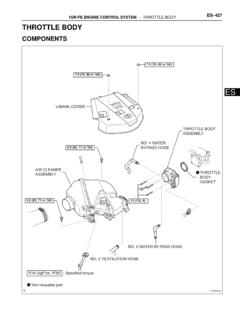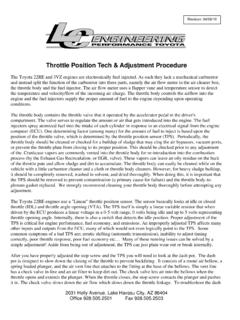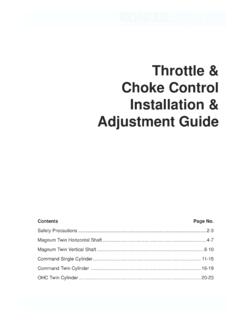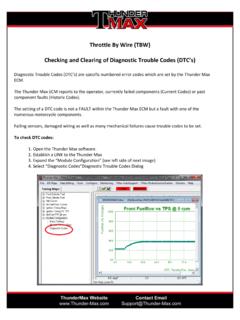Transcription of 2 POSITION THROTTLE CONTROL - Biondo Racing
1 INSTALLATION Remove your THROTTLE linkage (cable or rod) from your carburetor. The base of the air cylinder (cylinder B) has been tapped to fit either a solid rod (1/4 28) or a cable (10/32) linkage. In most cases it is necessary to reroute your ca-ble, move your cable mount back, or shorten your THROTTLE rod length (a THROTTLE stop cable bracket is available from BRP). Thread the adjusting bolt on cylinder B half way into the air cylinder and tighten the lock nut. Mount the square solenoid to a location within reasonable reach of THROTTLE CONTROL . Connect the line from the Co2 bottle regulator to the fitting on the rear of the hex piece of the round solenoid. Connect port 2 on the square sole-noid to cylinder B (top cylinder). Connect port 4 on the square solenoid to cylinder A (bottom cylinder). Adjust Co2 pressure to 80 to 85 psi if it is not already preset. Open the Co2 bottle and check for leaks at fittings us-ing soapy water. Keep the Co2 bottle open for the completion of the installation.
2 Attach the front end of the THROTTLE CONTROL to the quick connect ball on the carb linkage. Open the THROTTLE butter-flies wide open by hand and align the THROTTLE CONTROL with the rod or cable, side by side. For rod type linkages, mark the rod at the point where the threaded adapter ends. Leaving an additional 1/2 inch for threads, cut the rod at this point. For cable type linkages, move the cable mounting bracket back until the THROTTLE CONTROL can be threaded onto the cable. In some cases it may be easier to purchase a new (longer) cable bracket. Disconnect the THROTTLE CONTROL from the ball on the carb. Attach the THROTTLE CONTROL to rod or cable and tighten the lock nut on your rod or cable. Reconnect the THROTTLE CONTROL to the quick connect ball on the carb. You must now adjust your wide open THROTTLE on your solid pedal stop. (It is VERY important to have a SOLID pedal stop such as a bolt or tube welded to the chassis.) If your pedal stop is adjustable, screw the pedal stop in or out to achieve wide open THROTTLE with the gas pedal pushed firmly against the solid pedal stop.
3 If your pedal stop is not adjustable, wide open THROTTLE against the pedal stop can be adjusted by threading the THROTTLE CONTROL in or out of the THROTTLE rod or cable. Test the operation of the THROTTLE linkage at both full and closed THROTTLE to be sure there is no interference with the carb, manifold, firewall, etc. 2 position throttle control WIRING Connect the black wire of the square solenoid and either wire of the round solenoid to a good chassis ground. Connect the other wire of the round solenoid to the source for activation of cylinder B (cylinder B must be used for whichever function is going to have the most THROTTLE closing, this is usually the starting line rpm). If you are using the Mega 400 or Mega 300 this should be connected to the terminal used to CONTROL the starting line enhancer/ or EASY START. Connect the red wire of the square solenoid to the source for activation of cylinder A (cylinder A must be used for what-ever function is going to have the least THROTTLE closing, this is usually your down track THROTTLE stop to CONTROL ET).
4 If you are using the Mega 400 or 300 this should be connected to the THROTTLE stop terminal. OPERATION At this point you realize that this THROTTLE stop has 2 cylinders which gives you 2 different closed THROTTLE positions. You will have 2 separate closed THROTTLE positions to set. It should be noted that you have to adjust cylinder B s closed POSITION first. Once you have that set, you can adjust cylinder A s closed THROTTLE POSITION . Here s how it works: When Co2 is applied to the inlet of the round solenoid, cylinder B will close to it s shortest length -giving you full throt-tle. When 12 volts is supplied to the round solenoid the Co2 will exhaust and cylinder B will be pulled to it s longest length by the carbs return spring this will give you closed THROTTLE POSITION (#1). When 12 volts is supplied to the square solenoid the Co2 is exhausted from cylinder B and applied to cylinder A this gives you closed THROTTLE POSITION (#2) which is determined by the distance cylinder B can travel until it is stopped by cylinder A.
5 ADJUSTMENT OF THE CYLINDERS CYLINDER B: Disconnect the unit from the quick connect ball stud. Loosen the lock nut on the adjusting bolt in cylinder B. Turning the adjusting bolt counter clockwise will allow the THROTTLE to close more (this means less RPM for the Start-ing Line CONTROL ). Turning the adjusting bolt of Cylinder B clockwise will allow the THROTTLE to close less (this means more RPM for the Starting Line CONTROL ). CYLINDER A: Make sure you have adjusted cylinder B first. The THROTTLE closing of cylinder A is adjusted by the stop bolt of cylinder A. Loosen the lock of Cylinder A. Turning the adjusting bolt of Cylinder A clockwise will allow the THROTTLE to close more (this is opposite of cylinder B), this means less RPM for your downtrack THROTTLE stop. CYLINDER SPEEDS: OPENING SPEED - The adjusting screw in the brass hex where the Co2 enters will CONTROL how fast the THROTTLE opens. All adjusting takes place from all the way in to about 1/2 turn out.
6 This adjustment mostly effects how quick the THROTTLE opens on the starting line and has a minimal effect on the down track opening speed (we have tested this set-up to be more consistent when it opens quickly down track.) You should only use this adjustment if absolutely necessary. Tips on Using a THROTTLE Stop Written by Peter Biondo Through years of on track experience with THROTTLE stop Racing I have learned a few things about THROTTLE stops that can serve as a guideline to help in your THROTTLE stop Racing . 1/ FINDING THE RIGHT THROTTLE STOP "CLOSED POSITION " OR "BLADE ANGLE" - Finding how much to mechanically shut your THROTTLE down is crucial. You want to find a setting that will work well and be consistent. I have found 3 blade angles that work well (find the settings below). The most accurate way to adjust your "blade angle" is by RPM- (the rpm your engine drops to while the THROTTLE stop is engaged). Once you have the right THROTTLE stop RPM, you are done with the mechanical part of it, and all ET adjustments should be done with a timer.
7 As mentioned above, I have found 3 blade angles that work well: - A " THROTTLE stop rpm" of 3900- this will work well if your car runs 1 second under the index. - A " THROTTLE stop rpm" of 4300- this will work well if your car runs .3 to .9 under the index. - A " THROTTLE stop rpm" of 4800- this will work well if your car runs less than .3 under the index. ** If shifting on time, please refer to that section below as the suggested t/s rpm is different. 2/ FIGURING OUT YOUR THROTTLE STOP RATIO - Before figuring out your ratio you first must enter a number in timer 1 of your THROTTLE stop timer. This number indicates when the THROTTLE stop will come on after launch. Most people prefer to have this number set early for high mph. I recommend having the THROTTLE stop come on between .1 and .3. Once you set this, you will never adjust it again. To adjust your ET you will change timer 2. Whether you are using a weather station to predict a THROTTLE stop or not, I highly recommend you learning your THROTTLE stop ratio.
8 The THROTTLE Stop Ratio is the effect the THROTTLE stop time has on your ET. Here's an example- if you add 2 tenths (.2) to your THROTTLE stop timer and it changes your ET by 1 tenth (.1), then you have a 2 to 1 ratio. To learn your ratio do the following: Make one run with a small amount of time (duration) in the THROTTLE stop timer (.5). Make a second run with a large amount of time ( ). Let's say run # 1 was an and run # 2 was an You can figure out your THROTTLE stop ratio by dividing the change in the THROTTLE stop time by the change in ET. The change in THROTTLE stop time divided by the Change in = T/S Ratio. OR ( divided by = 2). This is called a 2 to 1 ratio. Learning your ratio will allow you to correct for changing track and air conditions. Your ratio depends on your " THROTTLE stop rpm". For most applications a 3900 T/S rpm results in a 2 to 1 ratio, a 4300 T/S rpm results in a 3 to 1 ratio, and a 4800 T/S rpm results in a 5 to 1 ratio. These ratios are based on cars equipped with converters that stall in the 5600-6400 area.
9 Extremely loose or tight converters will result in different ratios. 3/ YOUR THROTTLE LINKAGE - An "In-linkage" THROTTLE CONTROL is sensitive to the entire THROTTLE linkage system. It is very important to have an absolutely solid and rigid pedal stop. Without this you can stretch your linkage causing inconsistency. Your cable attaching bracket must also be rigid. Any flexing or binding will ruin the consistency. 4/ TIME SHIFTING WHILE ON THE STOP Is it beneficial to shift on time (have a timer shift the car during the stop duration) while on the stop? The answer really depends on how fast your car runs. Example: If your car runs well under the index (over 1 second under the index), you can gain consistency by shifting on a time. There are 2 major benefits for shifting on time. The car will come off the stop in high gear, lessening the chances of spinning the tires at that point. The rpm s on the stop will be much more stable when in high gear. In other words, your stop rpm s will climb at a much slower rate when in high gear compared to low gear.
10 This will result in more consistency and a more predictable THROTTLE stop ratio. ** Cars running less than 1 second under the index will most likely not benefit from shifting by time. ** When shifting on time, it is good have it shift a few tenths (.3 to .9) after the stop comes on. ** When shifting on time you should raise your THROTTLE stop rpm 300 higher than the suggested rpm mentioned in the above #1 example. (Example: cars running one second or more under the index should have a THROTTLE stop rpm of 4200 as opposed to the 3900 suggested rpm described above.) 5/ SPEED CONTROLS- Necessary or not? Speed controls are a way to slow down how fast a (CO2 powered) THROTTLE stop either comes on or comes off. This can be especially beneficial in higher powered cars and on greasy, hot tracks. If you have a high horsepower car, and the car comes off the stop in first gear (shifting on rpm), it is a good idea to slow down the THROTTLE stop opening speed to 50% to 60% speed.










